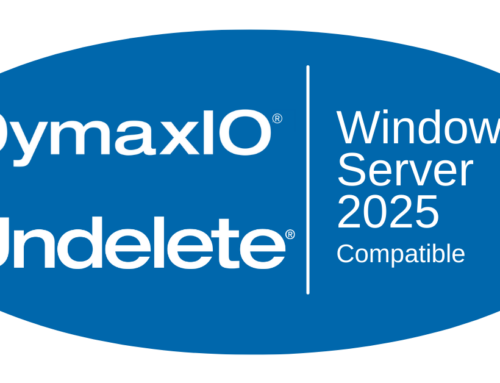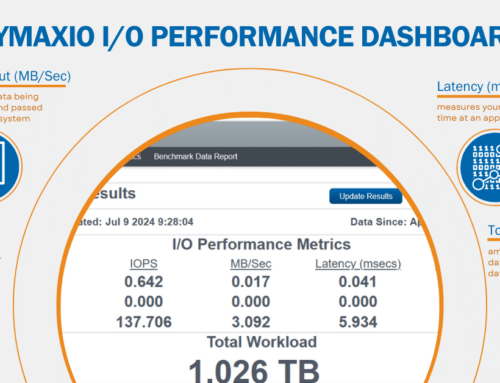In the ever-evolving landscape of IT infrastructure, the persistence of I/O bottlenecks remains a formidable challenge for system administrators and database administrators (DBAs). These bottlenecks, arising when the flow of data between storage and processing components encounter obstacles, can profoundly impact system performance. This blog post aims to unravel the intricacies of how I/O bottlenecks manifest, explore their impact on overall efficiency, and introduce Condusiv Technologies’ DymaxIO® I/O optimization software as the fast, easy, and cost-effective solution to address these challenges head-on.
The Anatomy of I/O Bottlenecks
I/O bottlenecks can emanate from various sources, each contributing to the hindrance of data transfer efficiency. One factor is the exponential growth in data volume and complexity, placing an increased demand on storage infrastructure. As systems grapple with the sheer magnitude of data, read and write operations may experience delays, resulting in sluggish performance.
A primary contributor to I/O bottlenecks is what we commonly refer to as split I/Os. These refer to additional I/O operations necessitated by the file system breaking up a file into multiple fragments, resulting in excessive traffic to and from storage. In the pursuit of a dynamic file system accommodating varied file sizes, scalability, and accessibility through different I/O sizes, files are inherently divided into multiple pieces. With the escalation in volume sizes and the proliferation of files on a volume, split I/Os become a more pronounced issue.
While not all file fragments threaten I/O performance, the reality is that, more often than not, I/O operations are not aligned with file allocations. Consequently, a single I/O tasked with processing data for an application may be split into multiple I/Os by the file system. This issue intensifies when free space becomes severely fragmented, accelerating the rate of overall fragmentation and the corresponding occurrence of Split I/Os. Recognizing that Split I/Os are detrimental to storage performance, the prevention and elimination of such occurrences emerge as pivotal measures, offering one of the most straightforward ways to significantly enhance storage performance.
The Impact of I/O Bottlenecks
The repercussions of I/O bottlenecks extend beyond mere inconvenience, significantly affecting the overall performance and responsiveness of a system. Slower data access times translate to delays in executing critical tasks, hampering productivity and user satisfaction. In scenarios where real-time data processing is essential, such as in financial transactions or database queries, the impact of I/O bottlenecks can be particularly severe.
Moreover, the wear and tear on hardware components due to excessive I/O operations can lead to a shortened lifespan of storage devices, posing long-term implications for organizations, requiring frequent hardware replacements, and contributing to increased operational costs.
Introducing DymaxIO: The Fast, Easy, Cost-Effective Solution
In the quest to overcome I/O bottlenecks, administrators are often faced with the dilemma of choosing between complex, expensive hardware upgrades and more streamlined software solutions. Condusiv Technologies’ DymaxIO emerges as the ideal solution, offering a fast, easy, and cost-effective way to optimize I/O operations without the need for extensive capital expenditure or disruptive infrastructure overhauls.
DymaxIO introduces a suite of intelligent technologies designed to elevate I/O performance. Consider IntelliMemory®, a patented read I/O optimization engine that leverages available DRAM to efficiently cache frequently accessed data. This server-side DRAM read caching engine specifically targets the most demanding I/O operations, substantially diminishing reliance on storage devices. The result is expedited data retrieval and heightened system-wide responsiveness.
Revolutionizing write operations, IntelliWrite®, a patented write optimization technology, effectively addresses issues related to excessively small, fragmented, and random writes and reads. By providing Windows with file size intelligence, IntelliWrite optimizes allocation at the logical disk layer, facilitating large, contiguous writes and reads. This intelligent approach minimizes I/O operations, countering the adverse effects of split I/Os, ultimately leading to superior system performance.
The Easy Implementation of DymaxIO
One key advantage of DymaxIO is its seamless integration into existing environments. Unlike the intricate process of hardware upgrades, DymaxIO operates at the software level, requiring minimal configuration and causing no disruption to daily operations. This non-intrusive approach enables organizations to enhance their storage performance without the complexities and downtime associated with extensive hardware replacements.
Cost-Effective Optimization with DymaxIO
DymaxIO stands out not only for its effectiveness but also for its cost-efficiency. Organizations can achieve significant performance improvements without incurring the substantial costs associated with rip-and-replace hardware upgrades. By maximizing the use of existing resources and mitigating the impact of split I/Os, DymaxIO provides a cost-effective solution for organizations seeking to optimize their systems.
Case Studies: Real-world Success with DymaxIO
To illustrate the tangible benefits of DymaxIO, let’s explore a couple of real-world case studies where organizations have leveraged this solution to overcome I/O challenges and achieve remarkable improvements in storage performance.
1. Case Study 1: Critical ERP System Bottleneck Resolved for Manufacturing Company
Challenge: SQL “waits” were increasing to access the database and the ERP system, and users were getting out-of-memory alerts, with clients and devices crashing.
Solution: DymaxIO was implemented to nondisruptively optimize I/O operations at the source, reducing the I/O requirement for all files.
Outcome: DymaxIO solved the performance problems – no more bottlenecks, waits, or crashes. Orders move from sales to shipping in real-time, saving a day of productivity and improving efficiency.
Read full case study Altenloh, Brinck & Co. – “Everything is More Responsive!”
2. Case Study 2: SQL and Oracle Performance Doubled on Flash Arrays for University
Challenge: Supported by an all-flash storage array, performance degradation was occurring on MS-SQL and Oracle applications on Windows servers impacting Quality of Service (QoS) to users.
Solution: DymaxIO was deployed to address the thousands of excessively small, tiny writes and reads that were dampening performance significantly.
Outcome: The university saw a 50% to 100% (and more increase in some instances) in performance on their MS-SQL and Oracle Servers, increasing the infrastructure efficiency and user productivity.
Read full case study University of Illinois – “2X Faster SQL & Oracle”
See For Yourself with Free 30-Day Trial
It’s easy to see for yourself. Download a free 30-day trial of DymaxIO and install it on your most troublesome server(s). Let it run for a few days and then check your performance results!
Conclusion
I/O bottlenecks represent a pervasive challenge in the realm of IT infrastructure, impacting the efficiency and responsiveness of systems. As organizations navigate the landscape of performance optimization, understanding the sources and consequences of I/O bottlenecks is crucial. Condusiv Technologies’ DymaxIO emerges as a beacon, offering a fast, easy, and cost-effective solution to address the complexities of I/O bottlenecks, particularly those arising from split I/Os or fragmentation. By choosing DymaxIO, organizations can unlock the full potential of their existing infrastructure, ensuring optimal performance and efficiency for the challenges of today and tomorrow.






Leave A Comment
You must be logged in to post a comment.